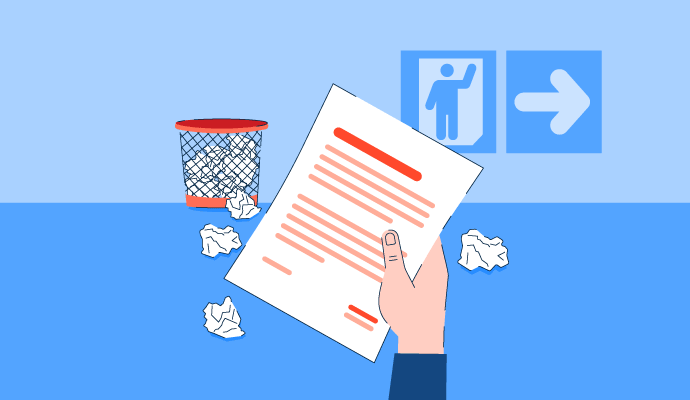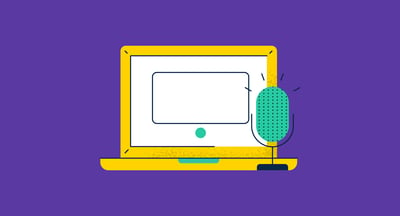

Plagiarism isn’t an academic word that disappears once you graduate.
Plagiarism isn’t as simple as borrowing someone else’s work, either. In short, plagiarism is theft. Whether written, multimedia (images, videos, graphics, music), or spoken word, using someone else’s content without proper attribution to the original source falls within the realm of plagiarism.
Many people utilize plagiarism checkers to avoid any time of funny business in their writing and double-check the legitimacy.
Plagiarism is the uncredited use of a person’s proprietary content that is passed off as original content by someone else.
You’ve heard about plagiarism more times than you can count but still don’t understand what the big deal is. Everyone does it, right? (No, they don’t.)
Plagiarism, though not technically illegal or criminal, can classify as a crime depending on the severity of the case. If you’re copying an essay, quotes from a book, an online resource, or the contents of your coworker’s resume, that’s considered plagiarism. However, if you’re plagiarizing something that is protected by a trademark or copyright, you could be fined, sued, charged, or even put in jail.
So, to prevent yourself from accidentally (or intentionally) plagiarizing, keep reading to learn about the five types of plagiarism and how to stop yourself from committing this morally questionable offense.
The following five types of plagiarism are the most common yet super easy to avoid. Although many are specific to academic writing (e.g., essays and research papers), anything below is applicable to business professionals with writing-heavy job functions as well.
Any time you use a quotation, whether it’s a couple of words, a few sentences, or a large block of text, you have to attribute the quote to the person who originally uttered (or wrote) the words you’re referencing. To do this, list the person by name and include quotation marks around any and all words belonging directly to the speaker/writer.
In the academic world, you’ll most likely be using MLA, APA, or CMS citation style guides for your classwork (unless in a specialized concentration), so make sure you know which one you’re supposed to use for your specific course.
In the professional world, simply referencing the person by name (first and last) and the work from which you are quoting will suffice. Otherwise, sticking with MLA format is always a safe choice.
Especially popular among college students facing strict deadlines for midterms and final exams that consist of an essay portion, essay writing websites might seem like a hero in disguise. These sites promise 100% original content within a certain timeframe (e.g., in 24 hours or three days, depending on how quickly you need your paper).
However, while this method might seem failsafe, many online essay-writing websites reuse essays that their essay writers had once created for someone (100% originally, as promised) and send you, the naive buyer, a copy of a previously-written paper about the topic you requested an essay for.
Because you cannot guarantee that they have hand-crafted a brand new essay for you, you could potentially be accused of plagiarism if you turn it in and someone else had submitted it before you – even if it was at a school or institution far from yours.
It’s not like you can go to your professor and make a claim that the paper isn’t plagiarized because you bought it brand new online. Then, not only are you a plagiarist, but you’re also a cheater. It’s not a good look.
Even if you’re not a student anymore, you were at some point, meaning you definitely had friends who took a class before you did and vice versa. Many instructors stick with the same syllabus semester after semester, year after year. So much work goes into creating a syllabus that they don’t want to overhaul and create another one for the same class they’re teaching for the 12th time.
Students are wise and know this from talking to each other. So if your friend took a class on the history of artificial intelligence in the fall semester of 2020, and you plan to take it in the spring semester of 2023, you’re already aware of the fact that there’s a 10-page final essay you’ll need to write. But you don’t like writing, and your friend got an A on their final essay, so you figure it’s been long enough that you can re-submit the paper with your name on it, and you’re good to go.
Well, not only do instructors have a pretty good memory, but they can also use plagiarism-checking websites to give them an extra layer of security in confirming the originality of your final paper.
Plus, if you get caught plagiarizing, you’ll definitely fail the paper, fail the class, and both you and your friend can be expelled for such an offense. But hey, those are the consequences of plagiarism.
Students who are struggling with starting or completing a paper will usually take their professor’s advice and seek help at their university’s writing center from a writing tutor. But a large number of students take the word help a bit too liberally and expect a writing tutor to, well, write their paper for them.
While writing tutors are beneficial resources for assisting in the completion of an assignment, finding more source material, or helping a writer with learning how to rework their content, tutors aren’t there to write or rewrite students’ papers.
If you ask a writing tutor to “reword” or “rephrase” a large chunk of a paper you’ve written, or ask them how they would say something with the expectation that they give you a word-for-word response that you can copy and use as your own words, that’s plagiarism.
Writing tutors should be used to enhance your own writing while helping you learn how to become a better writer. Don’t take advantage of them!
Using an old paper you wrote for a class years ago, or an article you published on your former employer’s website and trying to pass it off as freshly written or “repurposed” content is considered self-plagiarism.
You’re probably thinking, but I can’t plagiarize myself! Well, actually, you can.
Self-plagiarism is pretty simple. If you use the exact same content you’ve previously written and try to pass it off as new or “repurposed” content, you’re self-plagiarizing. Be honest with your reader and provide them with a note indicating that this is not the first use of or publication of the content they’re reading.
And hey, if your writing is in an online format, you can even link back to your other content and grow your site traffic!
You might not think that things like paraphrasing, source misattribution, and using content deemed to be “common knowledge” constitute plagiarism, but you’d be surprised.
To get around citing sources, people opt to paraphrase the content. However, there’s a fine line between paraphrasing something and usurping content that someone else wrote first. You might come across the most informational source about the topic you’re researching (and have to write about), and you think that they say what you need to say better than you ever could. So you decide to copy and paste directly from their website and change some words here and there, but keep the general idea of what they said intact.
Guess what? That’s still plagiarism.
Just because you add a few flowery words and switch the order of the text from the original source doesn’t mean you’ve created something original. To make sure you aren’t accidentally plagiarizing, give credit to the author of your original source or the website where your source material came from. You don’t have to use quotation marks because you aren’t directly quoting the source, but you should reference your source by name as a way to cite them.
In the same way that not citing your source constitutes plagiarism, so does citing an incorrect source. Just because you read that one person said or wrote a famous quote you’ve heard a hundred times doesn’t mean that the person you heard it from actually said it first.
Words and phrases like Abraham Lincoln’s “four score and seven years ago” or Martin Luther King, Jr.’s “I have a dream” are considered common knowledge. So yes, we all know that Lincoln gave The Gettysburg Address and that MLK Jr. gave the I Have a Dream speech; however, you should still note the source (person) whose common words and phrases you’re using.
Simply noting “When MLK Jr. said he had a dream…” in your writing would be sufficient in this instance. Nobody’s going to confuse Lincoln or MLK Jr. with someone else, and everybody knows who they are.
If you're on the receiving end of some fishy content, you may be wondering how to find out if plagiarism is involved. Here are some quick tips to keep in mind while you figure that out.
It's not easy to determine at first glance whether something is plagiarized or not. Plagiarism checking software save the day by automating the way you catch some wary writing.
To qualify for inclusion in the plagiarism checker software category, a product must:
* Below are the top five leading plagiarism checker platforms from G2’s Winter 2023 Grid® Report. Some reviews may be edited for clarity.
Grammarly Business is an AI-powered writing assistant that helps businesses expedite the writing process with tools like a grammar checker, plagiarism checker, citation generator, style guide, and more.
“I like that Grammarly provides accurate, thorough, and easy-to-understand grammar and spelling checks. It helps me to quickly identify and correct any potential errors in my writing. Additionally, it has a wide variety of helpful writing tools like punctuation checkers, synonym finders, and plagiarism detectors. Grammarly's intuitive user interface makes it easy to use, and its AI-driven technology ensures that the suggestions it makes are always reliable and up-to-date.”
- Grammarly Business Review, Eashan G.
“An aspect that I've found less helpful is that sometimes it does not catch all errors in the document, which can be frustrating if I'm relying on the software to catch everything. Additionally, Grammarly Business does not have the capability to detect cultural and regional variations in the language. This means it may flag certain words or phrases that are perfectly fine to use in specific regions or cultures but not considered appropriate in others. Lastly, the price point can be quite expensive for small businesses or independent users like me, which can be a limitation for those who want to use it but do not have the budget for it.”
- Grammarly Business Review, Ivette V.
Turnitin specializes in prioritizing academic integrity in the education industry. Turnitin's most popular tool is state-of-the-art plagiarism detection which is especially helpful in online learning environments.
“I have used Turnitin for over 5 years for checking the similarity index of academic papers. The software is the coolest software for anti-plagiarism. It has a good interface that allows you to navigate easily. When you check a document for plagiarism, the software gives you a report and links to the sources of the document. It uses several colours to differentiate the sources of your paper. Its pricing is fair and flexible. It has two sections for checking the instructor version and the student version. I hope it is going to develop a feature for checking content generated by AI tools such as Moonbeam and ChatGPT.
- Turnitin Review, Lamar R.
“Like most technologies, it's not going to catch everything. Plus, some of the flagged assignments might be legitimate student work, so be sure to double-check, especially if multiple students were allowed to work together to create a thesis or topic sentences.”
- Turnitin Review, James T.
Quetext offers a free plagiarism detection tool that is as easy to use as copy and paste. Users can download their Google Chrome extension to analyze their drafts and collect plagiarism scoring throughout the writing process.
“I like the reports and their overall plagiarism detector. I have tried to use other tools for plagiarism, but nothing came as close to Quetext. It was accurate and perfect. Really helpful, especially if you are writing a ton of documents on the internet.”
- Quetext Review, Tejas R.
“I think there is a disadvantage with Quetext where sometimes a content writer may write exact text without intention, so it may detect plagiarism. Its algorithm may mislead innovative content.”
- Quetext Review, Khursheed K.
PlagiarismCheck.org helps educators from K-12 and higher education identify potential plagiarism in their students' work. PlaigiarismCheck.org's detection tools help to identify paraphrasing, suspicious changes in sentence structure, grammar errors, and more.
“I love this website! It is so helpful! I use it to check my academic papers for plagiarism every time I need to submit a paper, and it helps me feel more confident about my writing.”
- PlagiarismCheck.org Review, Shristi L.
“It's a little difficult to navigate, and there are some paywalls to get through. The price is kinda high, considering there are free versions. The site should try to monetize a different way”
- PlagiarismCheck.org Review, Kyle M.
Unicheck is a plagiarism detection tool that prioritizes critical thinking. Unicheck offers its own AI writing assistant that helps users identify areas of detected plagiarism and aid them in remedying the issue and learning something from the experience.
“Unicheck is a powerful plagiarism checker that helps with an interface for ease of use and advanced plagiarism technologies to identify similarities and achieve authenticity. The software is ideal for all types of people with businesses or academic research purposes.”
- Unicheck Review, Victoria V.
“Some of the downsides to the program is it would sometimes group possible answers together, and flag answers similar to others.”
- Unicheck Review, Devon J.
Because detecting plagiarism with the naked eye isn’t always a foolproof solution, you might want a second opinion on determining the originality of a text. That's why automation is the way to go!
Find out what 2023 has in store for AI office technology trends and the new ways you can expose plagiarism with ease.
This article was originally published in 2019. The content has been updated with new information.

Use plagiarism checker software to avoid accidental plagiarism or to detect some suspicious writing activity.
Rebecca Reynoso is the former Sr. Editor and Guest Post Program Manager at G2. She holds two degrees in English, a BA from the University of Illinois-Chicago and an MA from DePaul University. Prior to working in tech, Rebecca taught English composition at a few colleges and universities in Chicago. Outside of G2, Rebecca freelance edits sales blogs and writes tech content. She has been editing professionally since 2013 and is a member of the American Copy Editors Society (ACES).

Use plagiarism checker software to avoid accidental plagiarism or to detect some suspicious writing activity.
Plagiarism is an unethical use of content, yet people still do it.
 by Anmol Kumar
by Anmol Kumar
Plagiarism means taking someone else's work or ideas and claiming they're yours. It happens in...
 by Sagar Joshi
by Sagar Joshi
Video interviewing is the process of virtually interviewing for an open job position using a...
 by Mara Calvello
by Mara Calvello
Plagiarism is an unethical use of content, yet people still do it.
 by Anmol Kumar
by Anmol Kumar
Plagiarism means taking someone else's work or ideas and claiming they're yours. It happens in...
 by Sagar Joshi
by Sagar Joshi
Never miss a post.
Subscribe to keep your fingers on the tech pulse.



